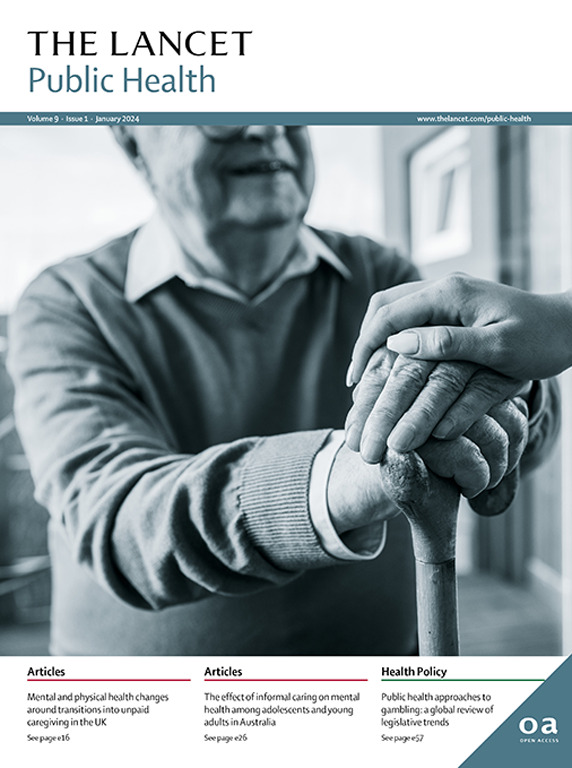在印度实施世界卫生组织包装食品钠含量基准的估计健康效益、成本和成本效益:一项模拟研究
IF 25.4
1区 医学
Q1 PUBLIC, ENVIRONMENTAL & OCCUPATIONAL HEALTH
引用次数: 0
摘要
背景膳食钠摄入过量与死亡和残疾有关。世卫组织发布了包装食品的全球钠基准,以支持各国减少居民钠摄入量。本研究旨在评估在印度实施这些世卫组织钠基准的潜在健康影响、成本和成本效益。方法我们使用了一个多队列、多州比例、生命表(马尔可夫)模型来估算如果包装食品中的钠含量符合世卫组织的基准与现状相比,成人的健康收益和成本效益。我们利用印度的特定膳食调查、食品成分表、食品销售数据和包装食品标签中的钠含量数据来估算干预前后的钠摄入量。有关血压、心血管疾病和慢性肾脏疾病负担的数据来自全球疾病、伤害和风险因素负担研究,减少钠对血压和疾病风险的影响是根据随机试验和队列研究的荟萃分析建立模型的。干预和医疗成本用于估算净成本,并计算每获得健康调整生命年 (HALY) 的增量成本。与目前的做法相比,在头 10 年中,遵守世卫组织钠基准估计可避免平均 0-3 百万人(95% 不确定区间 [UI] 0-2-0-5)死于心血管疾病和慢性肾病,平均 1-7 百万人(95% 不确定区间 [UI] 1-0-2-4)发生心血管疾病事件,以及 0-7 百万人(0-4-1-0)新增慢性肾病病例。预计在 10 年内,该干预措施可节约成本(概率为 100-0%),产生 10-0(0-6 至 1-4)亿 HALYs 和 0-8(95% UI 0-3 至 1-4)百万美元的成本节约。在整个人口生命周期中,该干预措施可预防 4-2 (2-4-6-0)百万人死于心血管疾病和慢性肾病,14-0(8-2-20-1)百万人预防心血管疾病事件,4-8(2-8-6-8)人预防新的慢性肾病病例,节约成本的概率为 84-2%,具有成本效益的概率为 100-0%。解释我们的建模数据表明,遵守世卫组织包装食品钠基准极有可能带来巨大的健康收益和成本节约,因此印度有充分理由强制实施世卫组织钠基准,特别是在包装食品消费量持续上升的情况下。本文章由计算机程序翻译,如有差异,请以英文原文为准。
Estimated health benefits, costs, and cost-effectiveness of implementing WHO's sodium benchmarks for packaged foods in India: a modelling study
Background
Excess dietary sodium intake has been associated with death and disability. WHO has released global sodium benchmarks for packaged foods to support countries to reduce population sodium intake. This study aimed to assess the potential health effect, costs, and cost effectiveness of implementing these WHO sodium benchmarks in India.Methods
We used a multiple cohort, proportional multistate, life table (Markov) model to estimate the health gains and cost effectiveness for adults if sodium content in packaged foods complied with the WHO benchmarks compared to the status quo. We used India-specific dietary surveys, food composition tables, foods sales data, and sodium content data from packaged food labels to estimate sodium intake before and after the intervention. Data on blood pressure, cardiovascular disease, and chronic kidney disease burden were obtained from the Global Burden of Diseases, Injuries, and Risk Factors study, and the effect of sodium reduction on blood pressure and disease risk was modelled on the basis of meta-analyses of randomised trials and cohort studies. Intervention and health-care costs were used to estimate net costs, and calculate the incremental cost per health-adjusted life-year (HALY) gained. Costs and HALYs were discounted at 3%.Findings
In the first 10 years, compliance with the WHO sodium benchmarks was estimated to avert a mean of 0·3 (95% uncertainty interval [UI] 0·2–0·5) million deaths from cardiovascular diseases and chronic kidney disease, a mean of 1·7 (95% UI 1·0–2·4) million incident cardiovascular disease events, and 0·7 (0·4–1·0) million new chronic kidney disease cases, compared with current practice. Over 10 years, the intervention was projected to be cost saving (100·0% probability), generating 1·0 (0·6 to 1·4) billion HALYs and US$0·8 (95% UI 0·3 to 1·4) million in cost savings. Over the population lifetime, the intervention could prevent 4·2 (2·4–6·0) million deaths from cardiovascular diseases and chronic kidney disease, 14·0 (8·2–20·1) million incident cardiovascular disease events, and 4·8 (2·8–6·8) new chronic kidney disease cases, with an 84·2% probability of being cost-saving and 100·0% probability of being cost-effective.Interpretation
Our modelling data suggest a high potential for compliance with WHO sodium benchmarks for packaged food being associated with substantial health gains and cost savings, making a strong case for India to mandate the implementation of the WHO sodium benchmarks, particularly as packaged food consumption continues to rise.Funding
WHO Country Office India.求助全文
通过发布文献求助,成功后即可免费获取论文全文。
去求助
来源期刊

Lancet Public Health
Medicine-Public Health, Environmental and Occupational Health
CiteScore
55.60
自引率
0.80%
发文量
305
审稿时长
8 weeks
期刊介绍:
The Lancet Public Health is committed to tackling the most pressing issues across all aspects of public health. We have a strong commitment to using science to improve health equity and social justice. In line with the values and vision of The Lancet, we take a broad and inclusive approach to public health and are interested in interdisciplinary research.
We publish a range of content types that can advance public health policies and outcomes. These include Articles, Review, Comment, and Correspondence. Learn more about the types of papers we publish.
 求助内容:
求助内容: 应助结果提醒方式:
应助结果提醒方式:


